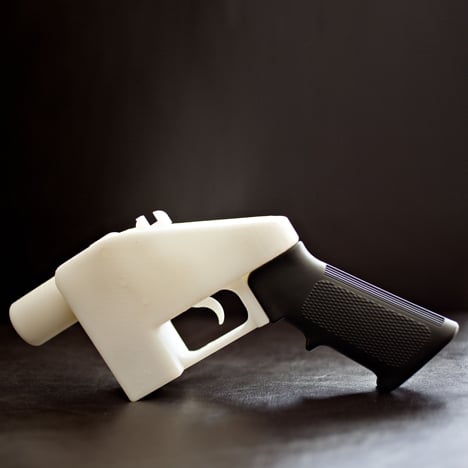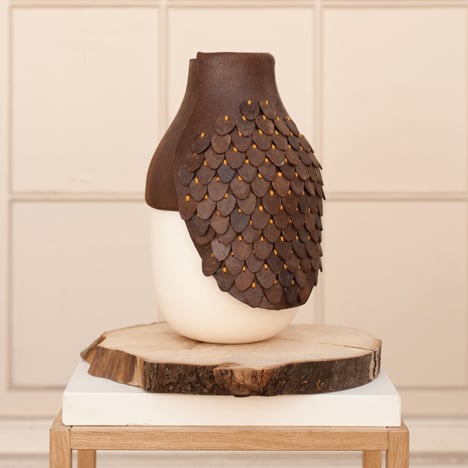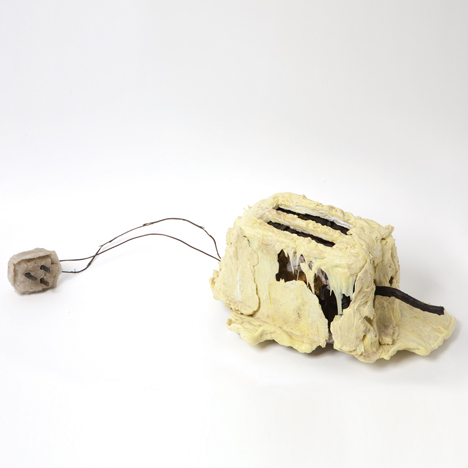V&A museum acquires first 3D-printed gun
London Design Festival 2013: London's V&A Museum has added the world's first 3D-printed gun to its permanent collection and will exhibit it along with four other newly acquired design objects during the London Design Festival. Update: senior curator at the V&A Kieran Long explains why the museum acquired the gun in this Dezeen and MINI World Tour movie.

The V&A, the world's largest museum of the decorative arts, has acquired two prototype Liberator guns, which were developed and successfully fired by Texan law student Cody Wilson earlier this year.
The gun sparked widespread concern over the ease with which weapons can now be produced on inexpensive printers, and the acquisition of such a controversial object marks a curatorial shift by the museum, which has traditionally focussed on hand-crafted items.
"Ugly and sinister objects demand the museum’s attention just as much as beautiful and beneficial ones do," wrote Kieran Long, the V&A's senior curator of contemporary architecture, design and digital, in an opinion column for Dezeen earlier this week. "Museums should be topical, responding quickly to world events when they touch our areas of expertise."
Wilson made the guns available for anyone to download and produce on a 3D printer via his company, Defense Distributed.
In a statement about the gun, the museum said: "The invention of this so called ‘wiki weapon’ sparked intense debate and upended discussions about the benefits of new manufacturing technologies and the unregulated sharing of designs online."
In May this year the US government forced Wilson to remove the blueprints for the gun from the internet. In the same month, the police commissioner for New South Wales in Australia warned of the dangers posed by printed guns after his force downloaded and test-fired one of the weapons. "Make no mistake, not only are these things undetectable, untraceable, cheap and easy to make, but they will kill," the commissioner said.
The gun is one of five new purchases made thanks to The Design Fund to Benefit the V&A, which was set up in 2011 to allow the museum to acquire contemporary design items. Until now, the purchases have all been pieces of furniture.
The other four items bought this year are vessels from the Botanica series by Formafantasma, The Toaster Project by Thomas Thwaites, Ear Chairs by Studio Makkink & Bey, and the George chest of drawers by Gareth Neal - see below for full details.
Last year the fund purchased items by furniture makers Joris Laarman, Yuya Ushida and Boris Dennler while in 2011 it bought furniture by Nendo, Fredrikson Stallard and BCXSY.
See all our stories about 3D printing and read our feature about how 3D printing is changing the face of weaponry and warfare.
Here's the full statement from the V&A:
The Design Fund to Benefit the V&A Announces New Contemporary Acquisitions
The Design Fund to Benefit the V&A has this year enabled the Museum to acquire five contemporary design projects ranging from a series of vessels made of natural polymers to a 3D printed gun. They will all go on display at the V&A for the first time during London Design Festival (14-22 September).
Martin Roth, Director of the V&A, said: “The generosity of supporters of the Design Fund ensures that the V&A is able to acquire for our permanent collections some of the best and most exciting design projects of our time. This year’s acquisitions reflect an interesting combination of new technologies working with traditional crafts.”
Yana Peel, Founder of the Design Fund to Benefit the V&A, said: “We are thrilled that in its third year, the Design Fund to Benefit the V&A has continued to enable the acquisition of such meaningful works for the Museum. With 17 exceptional contemporary design projects now acquired through the collective generosity of the Fund's donors, a legacy is being built to represent the leading trends in design and society of today.”
The Design Fund was set up in March 2011 by arts patron Yana Peel, to bring together design enthusiasts with a shared passion for contemporary design and an interest in supporting the V&A’s aim to enrich people’s lives by promoting knowledge, understanding and enjoyment of the designed world. Over the last two years supporters of the Fund have enabled the V&A to buy a number of pieces by such international designers as Fredrikson Stallard, Joris Laarman and nendo. Some of the pieces are now on permanent display in the V&A’s new Dr. Susan Weber Gallery for Furniture, while others will go into future exhibitions.
These new acquisitions significantly enhance the V&A’s holding of contemporary design, a collection which reflects what is new, influential, innovative or experimental, and what is representative of current trends in design and society. The collection spans all aspects of design and art including fashion, furniture, craft objects, product and graphic design, digital media, architecture, photography, prints and drawings.
Details of the new acquisitions

Defense Distributed (Cody Wilson)
Gun: Liberator, 2013
Texan law student Cody Wilson developed and fired the world’s first 3D-printed gun, the ‘Liberator’, in May this year. His company, Defense Distributed, created designs for guns and gun components that can be downloaded by anyone anywhere in the world and printed out on a 3D printer. The invention of this so called ‘wiki weapon’ sparked intense debate and upended discussions about the benefits of new manufacturing technologies and the unregulated sharing of designs online. The V&A has acquired two Liberator prototypes, one disassembled gun and a number of archive items to enhance its collection of 3D printed objects and represent a turning point in debates around digital manufacturing. www.defdist.org

Gareth Neal
Chest of Drawers: George, 2008/2013 - artist’s proof from an edition of five
Neal is passionately interested in the history of furniture, and believes that designers must ‘look to the past to understand the future’. This 2013 chest of drawers made from ash is a development from an oak model made in 2008 and exhibited at the V&A. In certain positions the viewer can see the outline of a 1780s George III commode emerging from the rectilinear, contemporary chest of drawers. The idea for the surface of this piece came about when Neal made an error while learning computer drawing. To make George, Neal combines computer controlled routing machines, hand carving techniques, traditional craft and contemporary design. www.garethneal.co.uk

Studio Formafantasma (Andrea Trimarchi and Simone Farresin)
Botanica, 2012 - four prototypes and material samples
The vessels of the Botanica series are created as if in an era before oil was commonly used. The designers experimented with natural polymers extracted from plants and animals, aiming to develop a new aesthetic for a post-industrial world. Based on meticulous historic research, the objects challenge our current understanding of plastic materials and suggest new approaches towards sustainable alternatives. This project was commissioned by Plart, an Italian foundation dedicated to scientific research and technological innovation in the recovery, restoration and conservation of works of art and design produced in plastic. www.formafantasma.com

Studio Makkink & Bey (Rianne Makkink and Jurgen Bey)
Ear Chairs, 2003 - prototypes
These chairs were designed for an office reception space. Paired together, they form a mini-environment – the ‘ears’ can create privacy or define space and the arm-rest functions as a small table. The designers combined the chairs with carpet and wall panelling that referenced the Sunday-room of a Dutch farmhouse. Despite this nod to history, the chairs aim to introduce a radical new way of working and living. They have been widely imitated in a range of seating designs in recent years. www.studiomakkinkbey.nl

Thomas Thwaites
The Toaster Project, 2009
British designer Thomas Thwaites decided to build from scratch a simple household appliance that cost £3.49 at Argos. He extracted and processed the raw materials himself using homemade tools and built a crude, but functioning, toaster that he admits “will bear a very imperfect likeness to the ones that we buy – a kind of half-baked, hand made pastiche of a consumer appliance”. If it were to go on sale it would cost £1187.54 – showing the vast economies of scale of large manufacturers. www.thomasthwaites.com